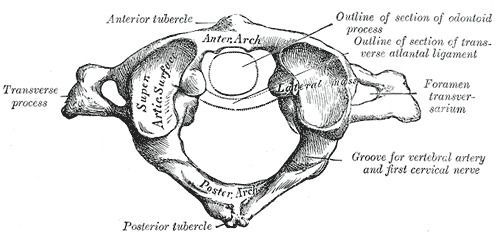What Is Orthospinology? Benefits, History, What to Expect & More
Orthospinology is a subspecialty of chiropractic healthcare targeted to the top two vertebrae of the spine.
Fixing misalignments in your upper cervical spine may address many underlying health problems , including seizures, chronic migraine, Parkinson’s disease, multiple sclerosis, high blood pressure, and more.
At Denver Upper Cervical Chiropractic , we employ the evidence-based techniques of orthospinology to bring relief to patients who have found little success with man-made medications or want to avoid invasive surgeries.
Listen to real customer testimonials about how upper cervical chiropractic care worked for them.
Read below for more on orthospinology, including what it treats and what to expect from a visit to your qualified orthospinology chiropractor.
What is orthospinology?
Orthospinology is a gentle chiropractic technique that aligns the upper cervical spine (top two vertebrae) to reduce pain, promote overall wellness, and relieve chronic health conditions. Orthospinology is a conservative alternative to pharmaceuticals or surgery.
This subspecialty of chiropractic care focuses on the upper cervical spine, which consists of the upper 2 vertebrae:
Upper cervical chiropractic care is gentle, not rough. We are not trying to ‘crack your back;’ we are fixing how your upper spinal cord communicates with your brain stem. This is what sets orthospinology apart from other chiropractic care.
History of Orthospinology
In the 1940s, Dr. John F. Grostic developed the Grostic technique — the beginnings of orthospinology. The Grostic technique focused on optimizing:
- Analysis specificity — making sure diagnostics accurately identify the underlying problem
- Adjustment precision — making sure chiropractic treatment precisely targets the underlying problem
In the 1970s, Dr. John D. Grostic continued his father’s research. He expanded the list of upper spinal misalignment’s adverse effects on the central nervous system, based on overwhelming evidence.
Orthospinology was born from the Grostic technique. Clinicians sought to improve the reproducibility of adjustments while minimizing human error with gentle, precise instruments.
Orthospinology vs. NUCCA vs. Atlas Orthogonal
National Upper Cervical Chiropractic Association (NUCCA) defines and regulates the practice of manually adjusting the upper cervical vertebrae based on x-ray analysis. This practice is slightly different from orthospinology.
What is the difference between NUCCA and Orthospinology ? NUCCA adjustments are usually done by hand, but orthospinology procedures use instruments. A patient with good outcomes at a NUCCA office will typically have good outcomes at an orthospinology practice, and vice versa.
Atlas Orthogonal is a little different from orthospinology though they are both upper cervical low-force procedures.
The Atlas Orthogonal technique looks much like an orthospinology adjustment, but the instrument delivers the adjustment with a “percussive force” — essentially, a sound wave.
Orthospinology techniques utilize a similar percussive instrument for some types of misalignments, but a larger table mounted instrument with a mechanical excursion for more.
What causes neck misalignment?
The following events may cause neck misalignment:
- Poor posture, including during sleep or work
- Traumatic spine or head injury (sports injuries, motor vehicle accidents, falls)
- Repeated “minor” injuries to the spine (chronically wrong lifting, staring down at phones)
- A long, stressful labor
What causes atlas subluxation ? Traumatic injury is usually what leads to Atlas Subluxation Complex — a subluxation in your top vertebra. Poor posture and repeated injuries are common risk factors that worsen atlas subluxation.
What happens when C2 is out of alignment? When the C2 (axis) is out of alignment, you can expect pain, numbness, weakness, or even loss of bladder/bowel control. You should seek upper cervical chiropractic care to correct C2 misalignment and avoid chronic health problems or long-term complications.
What to Expect During Orthospinology Treatment
During the orthospinology treatment process, expect an initial consultation. On your first visit , upper cervical chiropractors may not administer an adjustment. Precise analysis and diagnostics are crucial to orthospinology, so chiropractors often take a few days to process results.
At your initial consultation, your upper cervical chiropractor may do a physical exam, digital x-ray analysis, maybe even a cognitive exam.
On your second visit , chiropractors will typically perform the first adjustment. Upper cervical adjustments are gentle. Forget about those rough twists and cracks. Orthospinology is gentle enough for children and grandmas alike.
These adjustments are often instrument-assisted. Sometimes, the instruments will be handheld. Other times, the instruments are mounted on advanced equipment.This video helps you know what to expect from an orthospinology adjustment.
At Denver Upper Cervical Chiropractic, we also have a post-adjustment room for patients to relax and cool down after spinal realignment. Our calming post-adjustment room contains:
- Zero-gravity chairs
- Weighted blankets
- Noise-canceling headphones with binaural beats
- Essential oil diffuser
- Gentle lighting
In our offices, we may also recommend upper and lower back stretches to help with certain conditions.
How long does it take to realign your spine?
It takes one adjustment to start realigning your spine. The total number of visits needed for total realignment varies by case and depends on the condition of the patient.
However, a handful of visits to your chiropractor every year are likely needed to maintain spinal alignment.
The Orthospinology Technique: Before and After
You can see in the below pictures that an orthospinology adjustment corrects a misaligned upper spine.
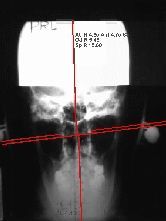
BEFORE
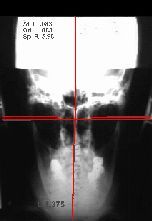
AFTER
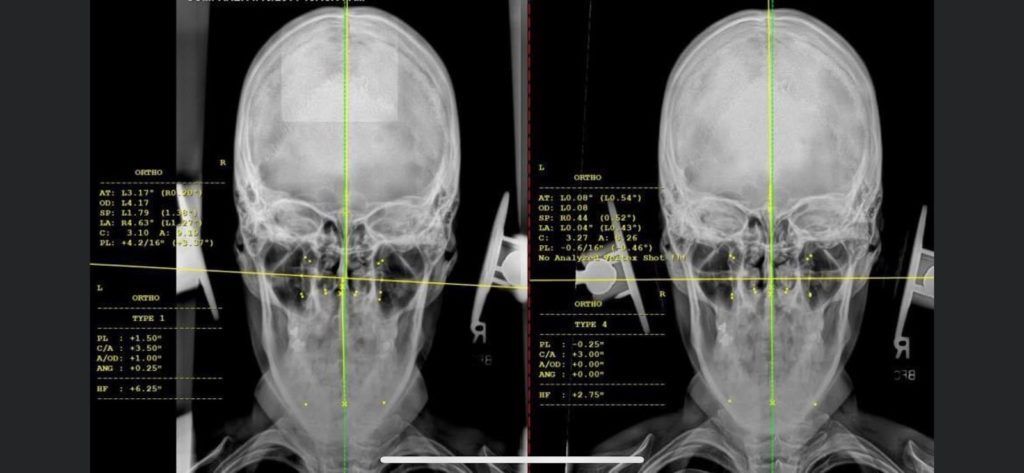
These before and after pictures from www.orthospinology.org show an average individual and how misaligned their spine may be before a spinal correction.

BEFORE

AFTER
Another method upper cervical chiropractors use is analyzing functional leg length by comparing the patient’s heels before and after adjustments.
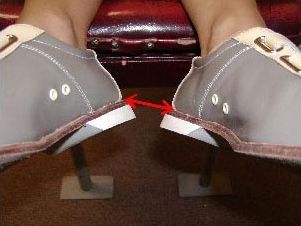
BEFORE

AFTER
Benefits of Orthospinology
Orthospinology aims to improve nervous system function, immune system function, body imbalance, and overall wellness. But what specifically do upper cervical procedures treat?
According to peer-reviewed research and case studies, the possible benefits of orthospinology /upper cervical care include improving medical conditions such as:
- Lower back pain
- Neck pain
- Knee pain
- Headaches and migraines
- Seizures
- Scoliosis
- Fibromyalgia
- Multiple sclerosis
- Parkinson’s symptoms
- Bowel dysfunction
- Asthma
- Low blood pressure
- High blood pressure
- Immune dysfunction (including when related to HIV )
- Tourette’s syndrome
- Cerebral palsy
- Autism spectrum disorder
Orthospinology as a Subspecialty of Chiropractic
Orthospinology is a subspecialty of the chiropractic profession. It takes many credit hours of additional education and certification before a chiropractor understands the complex structure and biomechanics of the upper cervical spine and is qualified to practice this subspecialty.
A Doctor of Chiropractic degree is a prerequisite to practice orthospinology.
The Society of Chiropractic Orthospinology is a non-profit organization that trains chiropractors in orthospinology. They provide orthospinology training through various seminars and workshops and offer testing for certification as an Advanced Graduate of Orthospinology.
Once a chiropractor has undergone the necessary education and certification, individual patients can be confident in the effectiveness of the adjustments to their upper cervical spine.
Orthospinology in the Denver, CO Area
At Denver Upper Cervical Chiropractic, we have administered countless upper cervical adjustments and witnessed amazing success stories. Orthospinology is critical to proper whole-body function and overall wellness.
Set up your appointment right away! We reserve Friday for patients traveling from outside Denver, CO.
New patient? Learn what to expect and how to move forward.
Find out about Dr. Ty Carzoli and his unique approach to spinal care.
- Woodfield III, H. C., York, C., Rochester, R. P., Bales, S., Beebe, M., Salminen, B., & Scholten, J. N. (2015). Craniocervical chiropractic procedures–a précis of upper cervical chiropractic. The Journal of the Canadian Chiropractic Association , 59 (2), 173. Full text: https://www.ncbi.nlm.nih.gov/pmc/articles/PMC4486989/
- Kirk Eriksen. (2001). POSITION PAPER FOR ORTHOGONALLY-BASED UPPER CERVICAL CHIROPRACTIC CARE. ORTHOSPINOLOGY UPPER CERVICAL. Full text: http://www.upcspine.com/tech5.htm
- Rochester, R. P. (2009). Neck pain and disability outcomes following chiropractic upper cervical care: a retrospective case series. The Journal of the Canadian Chiropractic Association , 53 (3), 173. Full text: https://www.ncbi.nlm.nih.gov/pmc/articles/PMC2732255/
- Chaibi, A., & Tuchin, P. J. (2011). Chiropractic spinal manipulative treatment of migraine headache of 40-year duration using Gonstead method: a case study. Journal of Chiropractic Medicine , 10 (3), 189-193. Full text: https://www.ncbi.nlm.nih.gov/pmc/articles/PMC3259914/
- Nick Tedder, D. C., Adam Tedder, D. C., & Stephen, J. Resolution of chronic fibromyalgia and improved spinal curves following correction of an atlas subluxation: a case report & selective review of the literature. Abstract: https://www.vertebralsubluxationresearch.com/2015/07/13/resolution-of-chronic-fibromyalgia-and-improved-spinal-curves-following-correction-of-an-atlas-subluxation-a-case-report-selective-review-of-the-literature/
- Bova, J., & Sergent, A. (2014). Chiropractic management of an 81-year-old man with Parkinson disease signs and symptoms. Journal of Chiropractic Medicine , 13 (2), 116-120. Full text: https://www.ncbi.nlm.nih.gov/pmc/articles/PMC4322011/
- Hannah, J. S. (2009). Changes in systolic and diastolic blood pressure for a hypotensive patient receiving upper cervical specific: a case report. Chiropractic Journal of Australia , 39 (3), 118. Abstract: https://search.informit.com.au/documentSummary;dn=354754121398890;res=IELHEA
- John D. Grostic, Jeffrey L. Selano, Brett C. Hightower, Bruce Pfleger, Karen Freeley Collins. (1994). The Effects of Specific Upper Cervical Adjustments on the CD4 Counts of HIV Positive Patients. Full text: https://www.upcspine.com/dloads/rs80.pdf
- Noriega, A., Chung, J., & Brown, J. (2012). Improvement in a 6 year-old child with autistic spectrum disorder and nocturnal enuresis under upper cervical chiropractic care. Journal of Upper Cervical Chiropractic Research , 1 , 1-8. Abstract: https://www.vertebralsubluxationresearch.com/2011/01/30/improvement-in-a-6-year-old-child-with-autistic-spectrum-disorder-and-nocturnal-enuresis-under-upper-cervical-chiropractic-care/
The post What Is Orthospinology? Benefits, History, What to Expect & More appeared first on Denver Upper Cervical Chiropractic.
Visit us at Denver Upper Cervical Chiropractic
We serve patients in Denver, CO.
HOURS
Monday 1:00 pm – 6:00 pm
Tuesday 9:00 am – 6:00 pm
Wednesday 1:00 pm – 6:00 pm
Thursday 9:00 am – 6:00 pm
Friday Reserved for Traveling Patients
1778 S Broadway, Denver, CO 80210, United States of America
Phone:
(303)-955-8270



